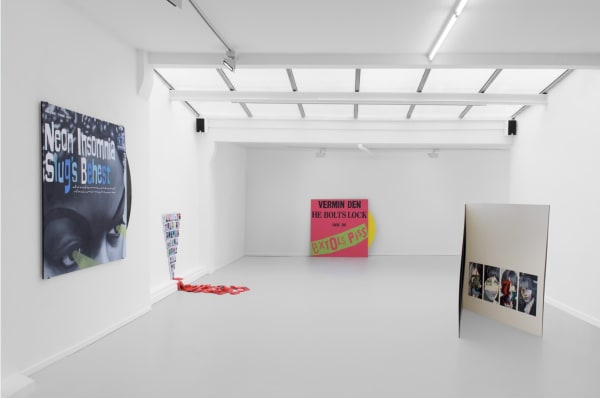Eric White: Monaural
It is with great pleasure that we announce the first solo exhibition by Eric White (US, 1968) with the gallery in Amsterdam.
Eric White’s paintings reference 20th century film, music and pop culture backed by consummate draftsmanship and painterly finesse to subvert and recode the dominant narratives of contemporary society. White’s paintings are constructed from elements of our collective consciousness, overflowing with an entropic visual overload.
For this solo exhibition White presents a new body of work that is a tribute to music and its lost forms, such as the LP and 8-track tape. A group of new paintings focuses on famous album covers, the recognition of their design is shared by many of us on an unspoken visceral level. We know these covers, always present in our visual memory, they are an expression of a period or particular time in our lives, but are we actually perceiving them anymore? White mixes up both the original content as well as the meaning of these images and forces us to look and interpret them again. As writer Mike Newton states in his essay about the LP paintings, “These are exercises in both loving fidelity to their widely revered sources, and cheeky impertinence in the face of fading cultural legacies.”
A large freestanding work is based on the legendary ‘White Album’ aptly titled The Beatles (2016). It is a centerpiece of the exhibition. White recre- ated the gatefold record as a sculpture painting five times the scale of the original, a monument to music. The Beatles’ portraits that are featured “As a movie is an invented reality, perhaps our reality is some sort of illusory projection of consciousness” in the original album design are re-constructed using elements from well known Richard Hamil- ton paintings, the original artist who designed the album, and the song titles have been re-shuffled into bizarre anagrams. Painted in oil on panel, this work resonates with wit while flaunting amazing artistic skills.
Another central work is titled Mingus! (2016) a painting that features a portrait of the jazz com- poser and bassist surrounded by his peers and influencers on a surreal 1930’s Busby Berkeley surreal stage set. The exhibition also includes installations constructed from 8-track tapes with modified labels; while vinyl is still around and making a come-back of sorts, the 8-track is officially dead forever. An installation of these tapes, all featuring central female figures is shaped into a massive pyramid symbolizing the power of music and memorializing a forgotten past. The 8-track installation is related to the album covers, is really an extension of it, but the formal difference is that these covers are created digitally, from a selection of actual vintage album covers with all text and extraneous elements re- dacted. For White these tapes connote a particular era in American culture, and a specific period of his childhood, underlining a certain nostalgic longing and sense of comfort.











